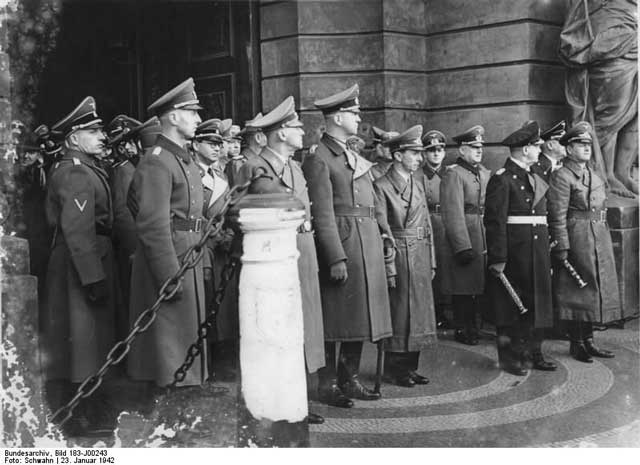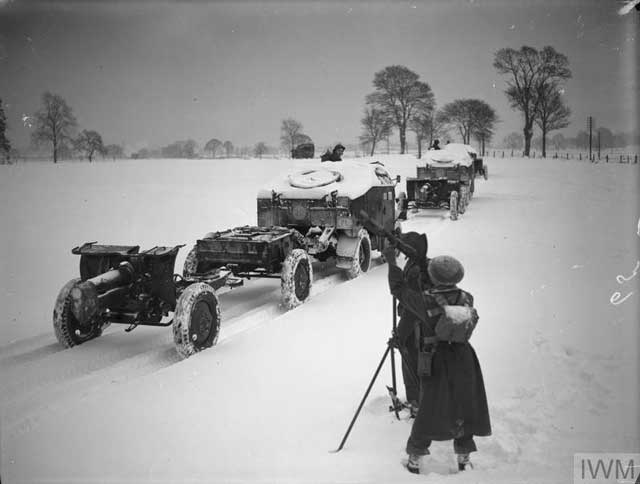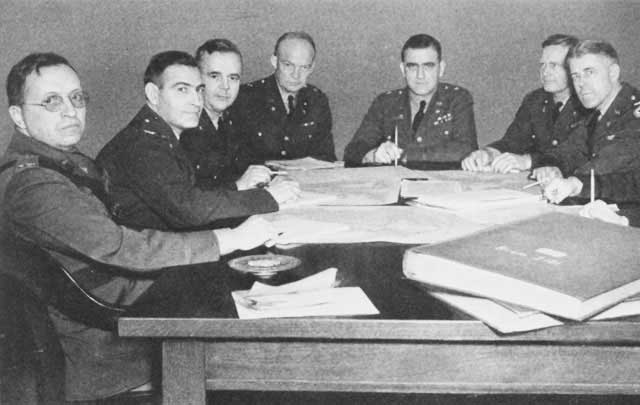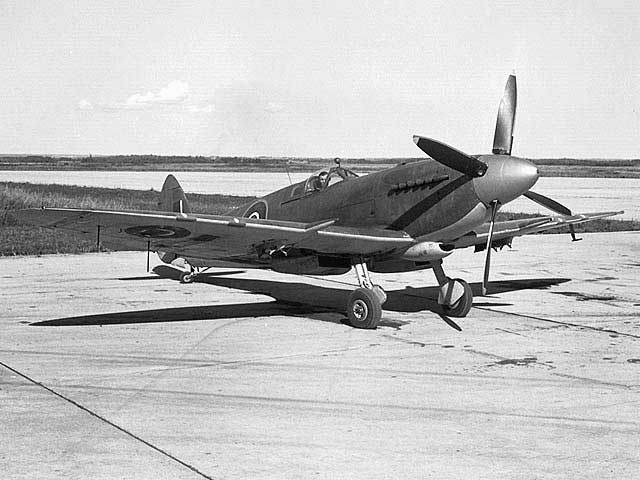Friday 23 January 1942
 |
| The funeral of Field Marshal von Reichenau in Berlin on 23 January 1942. Visible (among others) are Reich Minister Dr. Frick, Reichsleiter Bouhler, Generaloberst Fromm, Reich Minister Goebbels, Grossadmiral Raeder (in black), and Field Marshal Milch (at far right). Notably absent are Adolf Hitler and Reichsmarschall Hermann Goering (Schwahn, Ernst, Federal Archive Figure 183-J00243). |
Battle of the Pacific: Around 5,300 Japanese troops sail directly into Rabaul's Simpson Harbor on New Britain before dawn on 23 January 1942. They quickly evict defending Australian Lark Force troops from the vicinity and take the critical port of Rabaul. The Japanese 144th Infantry Regiment under Colonel Masao Kusunose brushes the Australians defending Vulcan Beach aside after a brief fight, but most of the landings are unopposed and the invaders quickly move inland. By nightfall, the Japanese have secured Lakunai airfield and Australian commander Lieutenant Colonel John Scanlan orders his civilians and soldiers alike to disperse into the nearby forests. The Australian troops lose two officers, 26 other men, and control of both New Britain and New Ireland Islands.
Many beaten Australian defenders of Rabaul remain at large in the interior of the two islands for weeks and some for months. There is no way to supply the men, so guerilla operations on any kind of large scale are impossible. The RAAF manages to get is people off New Britain at the last minute in flying boats and a Hudson, but the vast majority of Australians, around 1000, ultimately surrender after the Japanese make additional landings in the southern portion of New Britain. In any event, the Japanese are happy to just hold the northern portion of New Britain along the line of the Keravat River which contains the port and airfield. Northern New Britain turns into a virtually impregnable position due to the geography of the island - aside from a large-scale direct invasion such as that mounted by the Japanese. The invasion of New Ireland and New Britain is the beginning of the New Guinea Campaign.
In Burma, the 1st and 2d Fighter Squadrons, American Volunteer Group (the "Flying Tigers") have been giving a very good account of themselves since they began operation in late December 1941. Japanese pressure is increasing, however, and there are fierce air battles over Rangoon. The American pilots have a good day, shooting down five "Nate" fighters at 10:30. They also destroy five "Mary" light bombers and seven Ki-27 fighters after dark. The Japanese troops continue making slow but steady progress into Burma from Thailand.
On the Malay Peninsula, the Commonwealth troops evacuate Yong Peng after dark and head south. Some elements of the Indian 45th Brigade which escaped after the lost battle of the Parit Sulong Bridge manage to make it there through the jungles and swamps in the intervening five kilometers. British troops, the 2nd Loyals (North Lancashire), fight a desperate rear-guard action at Yong Peng against seven Japanese tanks which holds the road open just long enough for the fleeing 45th Brigade men to make it to safety. The British plan is to form a shortened line in the south to protect central Johore State, which serves as a buffer zone protecting Singapore. This line is projected to run Batu Pahat-Ayer Hitam-Kluang- Jemaluang. Lieutenant-General Arthur Percival, General Officer Commanding Malaya Command, is under no illusions, however. He now sets in motion the first stages of withdrawal from the mainland to Singapore Island, where the British still have not begun building defensive fortifications along the vulnerable north coast.
The Australians are holding in the Mersing area, where the bridge is destroyed (probably by the Australian defenders, though this is unclear). The Allies still have good mortar and artillery support that enables them to hold this line temporarily.
Japanese invasion forces moving south through the Makassar Strait and Molucca Passage land at Balikpapan, Borneo, and Kendari, Celebes Island, respectively. The Japanese troops at Balikpapan are in Major General Sakaguchi’s 56th Mixed Infantry Group and the No. 2 Kure SNLF. They quickly occupy the critical oil refinery which the Japanese project can supply a full third of their oil needs. The Dutch send airstrikes that accomplish little. Some Allied planes are based at Palembang, Sumatra, and RAF reinforcements begin arriving there today. However, the Japanese are moving quickly and bomb that airfield for the first time today. A Japanese landing force also heads out after dark and lands north of Kendari, Celebes Island, where they seize Kendari Airfield. The US Navy has four destroyers, USS Parrott, John D. Ford, Pope, and Paul Jones, in the vicinity of Balikpapan and they stage a daring raid on the unsuspecting Japanese invasion fleet lying at anchor offshore. In the first such night action of the war, the US destroyers use torpedoes to sink four (empty) enemy transport ships and a torpedo boat before slipping away undetected in the dark.
In the Philippines, heavy fighting continues in the II Corps sector western flank on the Bataan Peninsula. The Japanese force II Corps to begin withdrawing after dark to the final prepared defensive line. In the I Corps sector in the western half of the peninsula, the Japanese blocking force on West Road continues to hold out despite desperate Allied attempts to dislodge them and free a line of communications to the U.S. troops north of them holding the front. The Japanese cause further problems when a battalion of the 16th Division makes small landings far behind the Allied lines at Longoskawayan Point and Quinauan Point. The local US forces are taken completely by surprise and, despite increasingly frantic attacks, are unable to dislodge them.
Battle of the Mediterranean: Lieutenant General Erwin Rommel's "reconnaissance in force" is quickly developing into a full-scale offensive in Libya. The Afrika Korps panzers destroy 2 Armoured Brigade of 1 Armoured Division west of Saunnu on 23 January 1942. The British thus lose their only effective mobile formation. This opens the way for Rommel's forces to advance to Msus and thence on to Benghazi and Gazala.
The German security forces learn some valuable lessons during Operation Southeast Croatia, such as that their Croatian allies are of little help in the mountains due to poor equipment and training and the difficulty of operations in the mountains during winter. A more valuable lesson that could be learned but apparently is not is that encirclement tactics against partisans rarely work except against very large formations (such as those that have tanks and planes) because the partisans can act like locals and simply slip through almost any cordon. Surrounding a large area to "flush out" the partisans requires a vastly greater expenditure of troops and equipment than can ever be profitable for the small gains achieved. During Operation Southeast Croatia, for instance, the Germans use 20,000-30,000 troops, five panzer platoons, and an armored train. This is a vastly greater allocation of troops than the operation ever could have been worth even had it been entirely successful and cleared the target territory of its estimated 8000 partisans. Nothing of the sort results and partisans return as soon as the German security troops leave the vicinity - those that actually left in the first place, that is. The local German commanders can just point at a map and tell their commanders that they successfully cleared a large area - and who is to dispute them? They did - for a few weeks. So, the German authorities continue to believe that encirclement is a good tactic despite its ineffectiveness during Operation Southeast Croatia.
US Military: The Roberts Commission, formed following the attack on Pearl Harbor to study the circumstances surrounding the attack, concludes its investigation. The report assembles 2,173 pages of exhibits which form an invaluable resource for future students of the attack.
 |
| Japanese troops take Rabaul, 23 January 1942. |
 |
| "New Ireland. Japanese troops occupy Kavieng (formerly Kawieng) [New Ireland] on 23 January 1942." Australian War Memorial 127910. |
 |
| Capsized USS Cassin (DD-372) being salvaged at Pearl Harbor, 23 January 1942 (Navsource). |
The Australians are holding in the Mersing area, where the bridge is destroyed (probably by the Australian defenders, though this is unclear). The Allies still have good mortar and artillery support that enables them to hold this line temporarily.
 |
| The Balikpapan Oil refinery, which the Japanese take on 23 January 1942 (Collectie Stichting Nationaal Museum van Wereldculturen). |
 |
| "USS Cassin (DD-372), at left, and USS Downes (DD-375), Under salvage in Drydock Number One at the Pearl Harbor Navy Yard, 23 January 1942. They had been wrecked during the 7 December 1941 Japanese air raid. Photographed from the foremast of USS Raleigh (CL-7), which was undergoing battle damage repairs in the drydock. U.S. Naval Historical Center Photograph. Photo #: NH 54562." Navsource. |
 |
| An A6M2 Zero taking off from Japanese aircraft carrier Zuikaku on 23 January 1942. |
 |
| "Anti-aircraft Bren gun team stands guard as 4.5-inch howitzers of the 1st Heavy Artillery Regiment (1st Polish Corps), towed by Morris-Commercial 'Quad' artillery tractors, passing by in deep snow, Scotland." 23 January 1942. © IWM (H 16800). |
 |
| "A US Curtiss Biplane, used by the Royal Navy taking off for a patrol flight." Onboard HMS Victorious at Hvalfjord, Iceland, ca. 23 January 1942. © IWM (A 7311). |
Future History: Wilhelm Hermann Björn Bogner Jr. is born in Munich, Germany. He becomes a championship skier and competes in the 1960 Olympics. Later in that decade, Bogner turns to filmmaking and is most renowned as the cameraman for the skiing scenes in the James Bond films from "On Her Majesty's Secret Service" (1969) to "A View to a Kill" (1985). While engaging in these other pursuits, Bogner enters the family fashion business (primarily sportswear) and ultimately takes over his father's Bogner clothing brand (famous for the introduction of stretch pants as ski wear). As of 2021, Willy Bogner remains active in the fashion business.
1942
January 1942
January 1, 1942: Declaration By United Nations
January 2, 1941: Manila Falls to Japan
January 3, 1942: ABDA Command Announced
January 4, 1942: MacArthur on His Own in the Philippines
January 5, 1942: Soviets Plan General Offensive
January 6, 1942: US Army in Europe
January 7, 1942: Soviet General Offensive Opens
January 8, 1942: Hitler Sacks Hoepner
January 9, 1942: Battle of Dražgoše
January 10, 1942: Building the Jeep
January 11, 1942: Japan Takes Kuala Lumpur
January 12, 1941: Rommel Plans Counterattack
January 13, 1942: First Ejection Seat Use
January 14, 1942: Operation Drumbeat First Sinking
January 15, 1942: U-Boat Off NYC
January 16, 1942: Carole Lombard Crash
January 17, 1942: British Take Halfaya Pass
January 18, 1942: Soviet Paratroopers in Action
January 19, 1942: FDR Approves Atomic Bomb
January 20, 1942: The Wannsee Conference
January 21, 1942: Parit Sulong Bridge Battle
January 22, 1942: Parit Sulong Massacre
January 23, 1942: Japan Takes Rabaul
January 24, 1942: Battle of Makassar Strait
January 25, 1942: Kholm Surrounded
January 26, 1942: GIs Land in Europe
January 27, 1942: Battle of Endau
January 28, 1942: Rommel Takes Benghazi
January 29, 1942: First US Coast Guard Ship Sunk
January 30, 1942: Singapore Isolated
January 31, 1942: Army Group South Averts Disaster
2020
 |
| BBC Radio Times, Issue 956, 23 January 1942, covering the schedules from 25 January 1942 to 31 January 1942. |
1942
January 1942
January 1, 1942: Declaration By United Nations
January 2, 1941: Manila Falls to Japan
January 3, 1942: ABDA Command Announced
January 4, 1942: MacArthur on His Own in the Philippines
January 5, 1942: Soviets Plan General Offensive
January 6, 1942: US Army in Europe
January 7, 1942: Soviet General Offensive Opens
January 8, 1942: Hitler Sacks Hoepner
January 9, 1942: Battle of Dražgoše
January 10, 1942: Building the Jeep
January 11, 1942: Japan Takes Kuala Lumpur
January 12, 1941: Rommel Plans Counterattack
January 13, 1942: First Ejection Seat Use
January 14, 1942: Operation Drumbeat First Sinking
January 15, 1942: U-Boat Off NYC
January 16, 1942: Carole Lombard Crash
January 17, 1942: British Take Halfaya Pass
January 18, 1942: Soviet Paratroopers in Action
January 19, 1942: FDR Approves Atomic Bomb
January 20, 1942: The Wannsee Conference
January 21, 1942: Parit Sulong Bridge Battle
January 22, 1942: Parit Sulong Massacre
January 23, 1942: Japan Takes Rabaul
January 24, 1942: Battle of Makassar Strait
January 25, 1942: Kholm Surrounded
January 26, 1942: GIs Land in Europe
January 27, 1942: Battle of Endau
January 28, 1942: Rommel Takes Benghazi
January 29, 1942: First US Coast Guard Ship Sunk
January 30, 1942: Singapore Isolated
January 31, 1942: Army Group South Averts Disaster
2020











